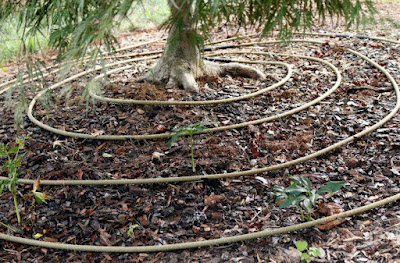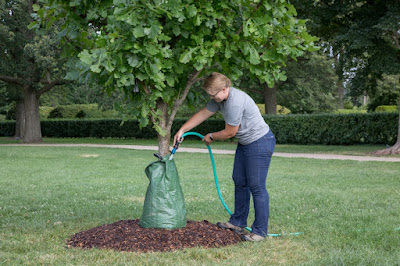Garden Guy and Friends: Care for Your Trees During the Dry Season
Monday, August 21, 2023
[Our Garden Guy has taken off August from his usual monthly writing duties. His guest columnist for this August issue is his long-time WSU Master Gardener colleague and fellow writer, Marty Byrne. Ed.]
 |
| Photo by JoeGardener.com |
Water needs differ for newly planted trees and established trees. Newly planted trees need routine more frequent watering for the first three years. More established trees have put down deep roots and require less supplemental water.
For all trees: Water deeply and infrequently rather than delivering more frequent shallow watering. Deep watering encourages deep root growth; shallow watering encourages roots closer to the surface with more negative impacts from summer heat and winter cold.
How do I know when to water?
How do I know when to water?
Check the soil around the base of the tree and at the drip line (the imaginary circle on the ground underneath the outermost branches of the tree’s crown). Gently dig 6 to 9 inches into the soil underneath the tree. Water if the soil is dry or barely moist. You can also use a water meter, available at most nurseries and garden centers.
Check newly planted trees every few days for the first three years; check established trees once or twice a month. Soil content may help determine frequency: Sandy soils will hold less water, requiring more frequent watering.
How do I know how much to water?
Check newly planted trees every few days for the first three years; check established trees once or twice a month. Soil content may help determine frequency: Sandy soils will hold less water, requiring more frequent watering.
 |
| Water bag. Photo by mortonarb.org |
For newly planted trees, thoroughly soak the soil several inches down. One guideline suggests two gallons of water, delivered slowly, for each diameter inch of trunk for the first three years.
A drip irrigation bag (seen left) around the base of the tree can also ensure the tree is getting enough water. Tree bags allow water to seep slowly to the roots.
Checking the soil around your established trees is the best way to determine if they need water.
Checking the soil around your established trees is the best way to determine if they need water.
Here the general guideline is one inch of water per week during dry periods. Use a soaker hose at the tree’s drip line to deliver water right to the roots.
Over-watering can be as detrimental as insufficient water. Roots need oxygen, and too much water fills up the spaces between soil particles.
Think mulch!
Over-watering can be as detrimental as insufficient water. Roots need oxygen, and too much water fills up the spaces between soil particles.
 |
| Mulch photo by pubs.nmsu.edu |
The list of benefits that mulch provides is a long one. Here are a few to consider:
What kind of mulch should I use?
- Reduces moisture loss around the base of the tree
- Controls weeds
- Provides insulation for the roots during high and low temperature extremes
- Improves the soil over time: aeration, structure, drainage
- Reduces the chance of damage to the tree bark caused by weed whackers and lawnmowers
- Certain mulches decompose over time, improving soil fertility
What kind of mulch should I use?
Wood and bark chips make the best mulch. They do not contain pesticides or dyes and because of the variety of material, decompose slowly, providing nutrients to the tree. Many tree services will give you the chips for free. You may get enough to spread on your other landscape areas and paths in addition to what you’ll need for your trees. Arborist chips may not be as pretty as bagged mulch, but they do a great job of protecting the tree roots.
Bagged mulches are also an option. The size of the pieces can range from fine to chunky. Choose a chunky mulch rather than one with very fine pieces. Chunky mulch allows air and water to pass through; fine mulches will become matted over time, impeding air and water flow. Avoid mulches with dyes, which will leach into the soil. You can also use an inorganic mulch like rock, pebbles or lava rock. Rubber mulches (ground or cut-up tires) are not a good choice as they can leach chemicals. They are also flammable, a genuine consideration now during our hot season.
How should I spread the mulch?
Bagged mulches are also an option. The size of the pieces can range from fine to chunky. Choose a chunky mulch rather than one with very fine pieces. Chunky mulch allows air and water to pass through; fine mulches will become matted over time, impeding air and water flow. Avoid mulches with dyes, which will leach into the soil. You can also use an inorganic mulch like rock, pebbles or lava rock. Rubber mulches (ground or cut-up tires) are not a good choice as they can leach chemicals. They are also flammable, a genuine consideration now during our hot season.
 |
| Photo by sacramentotreefoundation.org |
Keep mulch away from the tree trunk by eight to 12 inches.
Mulch applied too close to the trunk may lead to root rot or allow rodents to burrow near the trunk and chew on the bark during the winter months.
Spread it two to four inches deep out to the drip line for established trees, beyond the tree canopy for newly planted trees.
We value our trees in western Washington. Preparing for hot, dry weather will help our trees survive and be more resilient in our changing climate.
We value our trees in western Washington. Preparing for hot, dry weather will help our trees survive and be more resilient in our changing climate.
For further reading:
- US Forest Service Tree Owner’s Manual, https://usfs-public.app.box.com/v/TreeOwnersManual Comprehensive guide to planting and maintaining trees.
- University of Minnesota Extension,
- Watering established trees and shrubs
- Watering newly planted trees and shrubs
- Although out of our area, these are detailed guides for newly planted trees and established trees.
- International Society of Arboriculture (ISA) Infographic on the value of mulch and how to use it.
In addition to her horticultural volunteer efforts at the Shoreline Farmers Market and the Lake Forest Park Master Gardeners Clinic, Marty is also a freelance writer, editor and gardening columnist for the Master Gardener Foundation newsletter.






1 comments:
Just don't use mulch that's had a color added to make it all exactly the same.
Post a Comment